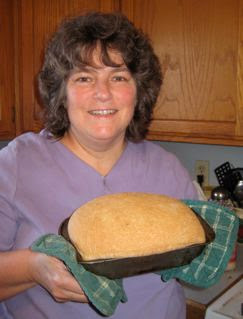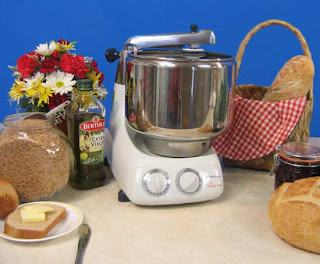
I received some requests for my bread recipes (after my blog about doing without stuff at the grocery store), so here it is for those who want to give it a try. My family has been raised on this delicious, healthy bread!
I make as much as I can at one time, but you can easily divide this recipe in half, or in fourths, for fewer loaves.
Diane’s Whole Wheat Bread
(makes 6 loaves)
8 cups hot water
1/2 cup fat (1 cube butter, olive oil, coconut oil, etc.)
1/2 cup honey
2 T. salt
2 T. instant yeast
23 (yep, twenty-three) cups freshly ground whole wheat flour (more or less)
Run tap water until it feels just hot to the touch (105 degrees). Pour water into the bowl of your bread mixer. Add fat and honey. Turn on the mixer and add 5 cups of flour while it is mixing. Add yeast. Continue to add flour until a dough has formed. Add salt.
You can substitute other sweeteners (molasses, sugar, fruit juice, etc.) if desired. You can leave the sweetening out altogether. French bread has neither sweetener or fat. It goes hard quickly, but it still makes great bread!
As the machine mixes the dough, add more flour. The moisture content of your wheat, the weather, the temperature of your water, and many other variables will determine the exact amount of flour you will need, but it will be 23 cups of whole “white” wheat, give or take a cup or so. (If you use hard red whole wheat, the amount may be as little as 18 cups.) As you add the flour, watch for a certain consistency of dough to develop that will make the best bread. You can test it by pressing your thumb into the dough after it has been kneaded. You can check while kneading, and if the dough feels sticky, but will not adhere to your thumb, you have the right consistency. Knead the dough for 9 minutes by machine (or 15 minutes by hand). You’ll soon be a pro on knowing exactly how much flour to add, but here are pointers. If you add too much flour, the bread will be too dry and heavy, and the sides will have a horizontal crack in them. If you do not add enough flour, the dough will be sticky and will rise but when baked it will cave in a bit and droop over the sides of the pan, unable to hold its shape. The perfect dough will rise and hold its shape firmly.
At this point you can shape the loaves or cover the bowl and let the dough rise for awhile (25 minutes works fine, but less or more is fine too). I have forgotten it for hours (more than once) and come into the kitchen to discover the bread dough had risen up out of the bowl and fallen out onto the floor. Anyway, that bread tasted great too!
Divide dough into 6 equal parts. Shape into a loaf by pulling the top smooth and tucking the dough underneath until you have formed a loaf shape. As you form each loaf, you may press the top of the loaves in a plate of sesame seeds, poppy seeds, flaxseed, oatmeal, or breakfast cereal crumbs for added texture. Put loaf into well-oiled loaf pans and place in an unheated oven to rise for 25 minutes. You can test that the bread is risen sufficiently by poking your finger in the edge of the risen bread near the pan. If the poke stays indented for 3 minutes, it is ready to bake. I just trust the timer, as 25 minutes always works for rising time at room temperature inside a cool oven. After it is risen, just leave the pans in the oven, and turn the oven on to 350° and put your timer on 35 minutes. The loaves will be nicely browned and hollow-sounding when tapped. Remove from pans to cool. Makes 6 yummy big loaves!
You’ll find this recipe, and other good recipes for using whole grains, in my cookbook: Hopkins Healthy Home Cooking.
Here’s some tips to ma ke your bread-making more successful:
ke your bread-making more successful:
When baking whole wheat bread, use narrow loaf bread pans, rather than the wide loaf pans, because whole wheat bread is heavier and cannot sustain such a wide arch in the rising stage. My favorite bread pans are narrow, heavy gauge metal and quilted to enhance their non-stickability.
I use a wheat called “White Wheat” or Golden Montana wheat, which is a high protein wheat with a lighter color. This bread dough is light enough to make into cinnamon rolls or pizza crusts. If you use hard red wheat, it will make an excellent hearty loaf of bread, but is too dense for other uses, in my opinion, unless you mix it with some portion of regular white flour from the grocery store, which I never like to do. So, I buy “white wheat” kernels.
For a more tender loaf, replace some of the water with the water left over from cooking potatoes. You can even add a cup of potato flakes to the dough while you are mixing it (which means you’ll need a bit less flour).
Yeast is very temperature sensitive and can be killed if added to water that is too hot. Instant yeast should not be mixed in water. Using instant yeast, and adding it once a batter has been formed, has always been successful for me. Yeast and honey are friends. Yeast and salt are enemies (yeast growth is retarded by salt: that’s why salt is such a good preservative as in beef jerky, pickles, etc.), so I add the yeast at the beginning of the process, after about 5 cups of flour is added. Then I add the salt at the end, after all the flour has been added, but the kneading is just starting.
You may add up to 2 cups leftover cereal (such as oatmeal, soggy corn flakes with the milk, etc.) to the dough with good results. Add it at the beginning with the water. If it is very wet, reduce the amount of water by 1/2 cup or so.
I know I am overly thrifty, but I save the crumbs from boxes of breakfast cereal, crackers, granola, nuts, and whatever else (rather than throw them out) and I throw them in the bread instead. Adds nutrition and variety, but most of all, it makes me feel very provident!
When shaping dough into loaves, or punching it down, just wet your hands by passing them under running water before handling the dough. It will prevent the dough from sticking to your hands.
prevent the dough from sticking to your hands.
You will need to mill your grain, and I’d like to pass on my hard-earned recommendation for the best grain mill on the market, the Wondermill. It is excellent for making quality flour from fine to coarse, and will even grind beans into flour (for instant refried beans) and popcorn into a bright yellow flour great for cornbread!
It really cuts down on hand labor to have a bread mixer. My favorite breadmixer is the Bread Mixer made by Electrolux (Swedish), which has been amazingly dependable. I’ve not had a repair ever on mine, and I’ve used it almost daily for 16 years now. I went through a bunch of mixers before making the investment, but it has been well worth it!
I spray my pans generously with olive oil cooking spray so that the loaves pop out easily. You can grease them with coconut oil, butter, shortening, lard, or cooking oil if you prefer.
Rub a cube of butter over the top of the hot baked loaf just out of the oven if you want to make it shiny and tasty, and the crust soft. Or you can quickly pass the loaf of the bread (still in the pan and hot—straight from the oven) under a running stream of water. The water hitting the hot bread makes steam and will soften the crust. I like the crust crispy, so I don’t do either of these.
Rather than get out a cooling rack, I just tap the pan on its end hard enough to pop out the loaf of bread. Then I balance the loaf across the top of the pan, as a make-shift cooling rack.
Don’t get too exacting. People have been making bread for thousands of years without a recipe. It is hard to make it wrong. The only tricky parts are: 1) the yeast: making sure it is working and that you didn’t kill it with too hot of water, or slow it down with cold water. You can see if the bread is rising, so that should be reassuring that your yeast is working! 2) adding the right amount of flour so it is substantial but not overly heavy and dry, and 3) baking it at the right point, when the bread is risen enough to make a light loaf, but not over risen so it deflates in baking. You’ll get this all right with practice. If it helps to know, I made toe-stubbing doorstops for the entire first year of marriage.
to know, I made toe-stubbing doorstops for the entire first year of marriage.
Best success—you’ll be making good bread it no time!


Comments on this entry are closed.